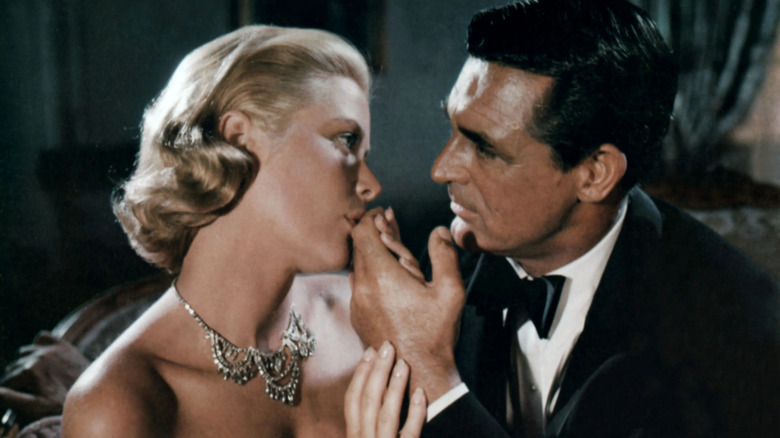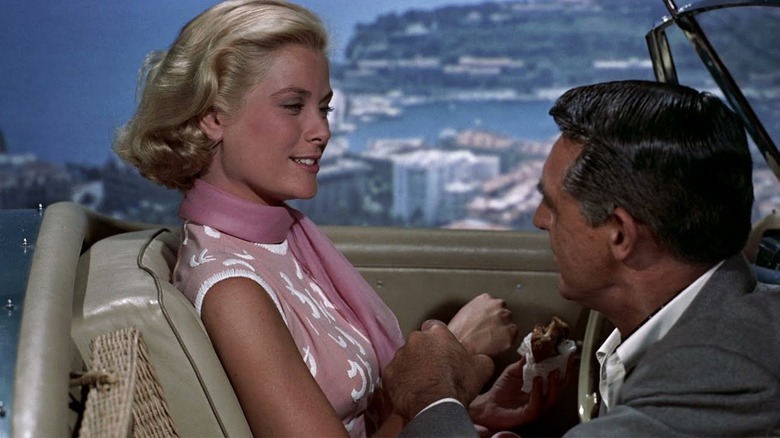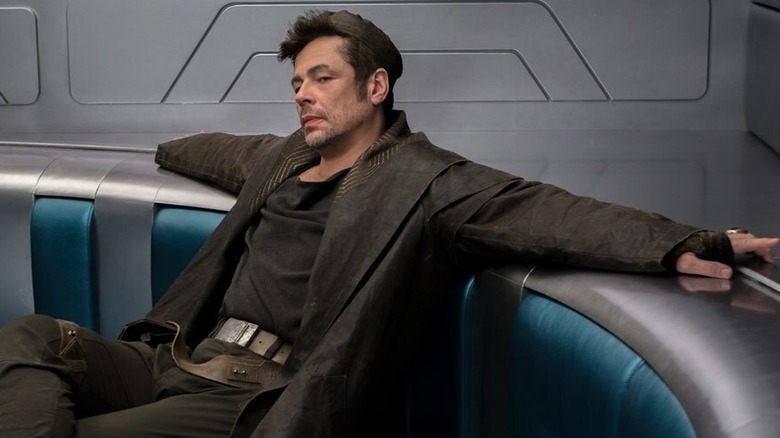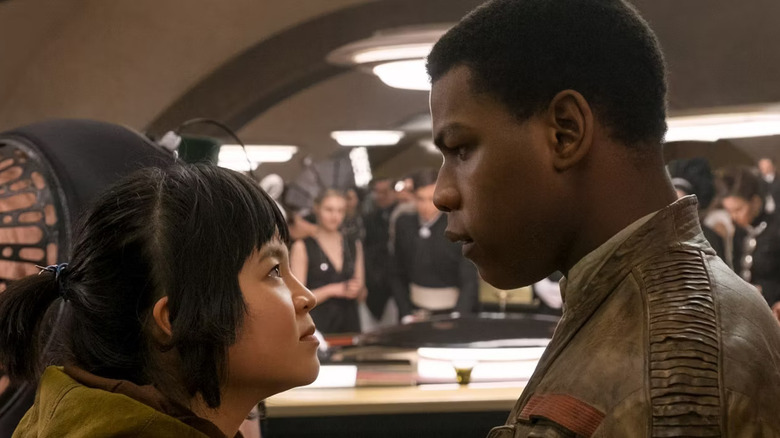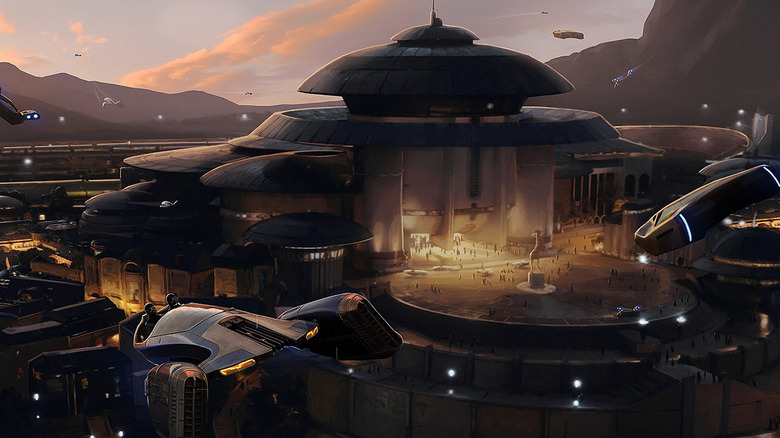Rian Johnson's Maligned Star Wars Masterpiece Was Inspired By Alfred Hitchcock
(Welcome to The Movies That Made Star Wars, a series where we explore the films and television properties that inspired George Lucas' iconic universe. In this edition: Alfred Hitchcock's 1954 romantic thriller "To Catch a Thief")
Alfred Hitchcock made a lot of movies in his storied career and there isn't a single one in his oeuvre quite like 1954's "To Catch a Thief". Released in 1954 and starring Cary Grant and Grace Kelly, "To Catch a Thief" tells the story of a retired jewel thief who is the subject of suspicion when a new string of robberies takes place in the French Riviera. He gave up that life after years in the French Resistance and a pardon on the other side of the war, and now he wants to catch the thief and clear his name because it takes a thief to catch one. Grace Kelly susses out Grant's true identity as the cat burglar and continues to hound him until she realizes that he's telling the truth and that she's actually in love with him.
This was the film Hitchcock used to lure Cary Grant out of semi-retirement, and was also his last with Grace Kelly. It was on the set of "To Catch a Thief" where Kelly first met the Prince of Monaco, whom she would later marry.
With the stakes in "To Catch a Thief" lower than many Hitchcock films, this one relies on the spectacle of the setting, the magnetism of the characters, and the twists and turns the story takes to provide the sort of tense fare that Hitchcock is most known for. It feels almost like a more personal James Bond film, but almost 10 years before the release of "Dr. No." With its opulent location photography, sweeping romance, and exciting chases, it's no wonder Rian Johnson leaned on it for images and elements inside of his space fantasy masterpiece "Star Wars: The Last Jedi."
Romance and grandeur of To Catch a Thief
"'To Catch A Thief'," Rian Johnson told Empire Magazine in the lead-up to the release of his "Star Wars" film, "was a great film to rewatch, for the romantic scale and grandeur."
Indeed, it's easy to see the influence on the surface of both movies. With the setting of the French Riviera, there's an aged history to the history, covered over in the modern sheen of casinos and a glamorous life. The way Grace Kelly and Cary Grant are photographed in these settings, with the sweeping vistas behind them, add an opulence to the film. This was the first film Alfred Hitchcock filmed in VistaVision — Paramount Pictures' answer to Cinemascope. Johnson brought that same mix of old-world and modern decadence to the streets of Canto Bight in one of the most (purposely?) misunderstood sequences in all of "Star Wars."
Johnson brings the same elegance and confidence of camera movement that Alfred Hitchcock was able to bring to bear. In fact, Hitchcock was one of the first to utilize helicopters to capture the landscape and chases in "To Catch a Thief" much the same way we see the swooping aerial shots of the Fathier chase. Though many point to the work of Spielberg when looking at Johnson's chase scene, they almost bear a larger resemblance to Hitchcock's fine chase construction seen in this film.
The look of the denizens of Canto Bight look to be inspired by "To Catch a Thief" as well. The climax of the film takes place at a fancy costume party with all of the attendees in ridiculous getup hearkening back to the powdered wigs of the old French aristocracy, Johnson and the design team merely put a classy "Star Wars" spin on it.
Moral relativism of The Last Jedi
One particular moment in "The Last Jedi" that feels inspired directly by Hitchcock's film is the scene where DJ (Benicio Del Toro) gives Finn (John Boyega) a speech about the lack of difference between the Resistance and the First Order because both are making the same people rich. In "To Catch a Thief," Cary Grant's character is left to explain to an insurance man (John Williams — not that John Williams — the character actor, not the composer) how everyone is a thief. He explains the moral relativism in what he used to do, how the insurance industry works, and how he might expense a meal he didn't pay for. It all adds up and it all comes to the same thieving conclusion. We like Cary Grant's character the same way we like DJ and Finn. These characters make valid points and we can't help but find ourselves nodding our heads along, even if we don't completely agree on an ethical or moral level.
Leave it to Benicio Del Toro to reinterpret the sort of convincing Cary Grant is able to do and sell it the way he does. It's sharp and worth watching.
Not-So-Subtle Subterfuge
Another element that feels ripped right out of "To Catch a Thief" and brilliantly put into "The Last Jedi" is a touch of the humor. Grace Kelly's character does not belong in the world of cat burglars and intrigue that she finds herself in, very much the same way Finn and Rose feel out of place in the high-rolling casinos of Canto Bight. It injects a needed humor into the situation (and it makes even more sense why Johnson would lean on "Brazil" as well for these sequences) and adds depth to the characters. Sometimes the absolute wrong character for a job in the story is the absolute right character for the story. Grace Kelly's character is out of her depth and almost out of place in these situations and her naive bumbling adds charm to the events on screen. Neither Finn nor Rose are equipped to be in a place like Canto Bight and that's where a good chunk of the humor of the scenes comes from. Fish-out-of-water scenes are always entertaining. There's a moment in "To Catch a Thief" where Kelly almost blows the cover of the job she's doing because she's simply not capable of playing the high-stakes games of undercover subterfuge and that's the same well Rian Johnson drew water from for Finn and Rose in the sequence.
All of this adds to the theme of Canto Bight as well, leaving every truth to the point of view of the character living it, each of them being different.
The editing is reminiscent of To Catch a Thief
Another thing that Alfred Hitchcock employs is subtext in the editing. Rian Johnson manages to do this in more subtle ways in "The Last Jedi," but Hitchcock was a pioneer in telling stories for a less sophisticated audience used to a slower pace of storytelling. But that doesn't mean Hitchcock doesn't have tricks to teach still. There's a sequence in "To Catch a Thief" where Cary Grant and Grace Kelly are flirting and discussing the core of their character while a fireworks display goes off outside. Instead of cutting to a sex scene, Hitchcock cuts to the fireworks as subtext, telling the story through the cuts themselves. Rian Johnson uses this technique of telling stories in the subtext of the cuts repeatedly in "The Last Jedi," making him and his editor, Bob Ducsay, masters of the technique.
For example, with Luke's question to Rey about where Han is. I know some fans wanted to see his tortured reaction, but we can imagine it better than Mark Hamill could ever deliver it. But by cutting directly to the spiritual successor to Han Solo and his killer in Kylo Ren, we are told a story in the subtext of that cut. It answers Luke's question and implies so much more than a monologue ever could.
The other cut that tells a complete story by shifting our understanding as the shot plays out is of the iron. Poe has just committed mutiny and we cut to inside Snoke's cruiser. The shot has a metal object, steaming like a landing platform, but it's revealed that we're in an automated laundry and we catch just a hint of Finn, Rose, and DJ escaping in stolen uniforms. These two simple shots tell the entire story and play directly into the theme of the film, toying with the audience's point of view, and delivering a laugh. It's such good stuff and has a direct lineage back to these Hitchcockian techniques, in particular, the line between epic and comedy like in "To Catch a Thief."
Rian Johnson's Cinematic Style
"The Last Jedi" might be the richest of the Disney-era "Star Wars" as far as cinematic influence, proving Rian Johnson went back to George Lucas's original modus operandi when piecing the sequences of the film together. From "Rashomon" and "Three Outlaw Samurai" to "Brazil," Rian Johnson brought influences that were personal to him to the canvas of "Star Wars." The "Star Wars" films were always at their best when they brought something new to the universe and Rian Johnson delivered in spades, reformulating and pushing boundaries with the eighth installment of the Skywalker saga. It wasn't everyone's cup of tea, to be certain — we hear from the vocal minority often — but no one with sense can deny that it's the most finely constructed of the new era of films and that is owed to Rian Johnson's keen awareness of the rich history of cinema George Lucas drew from, and his thorough study of "Star Wars" itself. It's no wonder Kathleen Kennedy signed Johnson up for his own, new "Star Wars" trilogy and I can't wait for it to eventually come to fruition.
It will be worth the patience required, just like a cat burglar waiting for the right time to strike.
